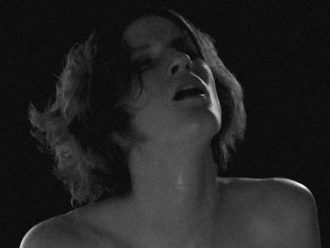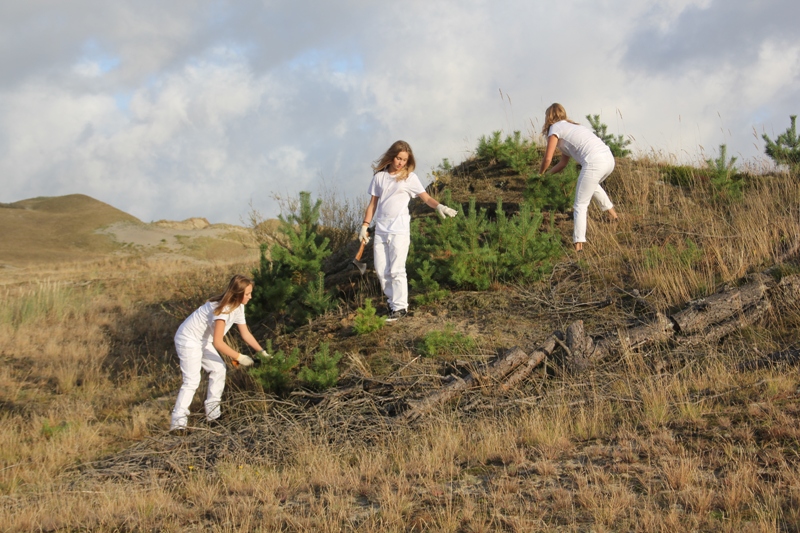
One of the first artists to arrive to Nida together with the beginning of autumn was Tanya Busse, a Canadian artist, who currently lives and works in Tromsø, Norway. Tanya primarily works with photography, publications and installation. For the residency in Nida Art Colony she proposed a short, ethno-fiction movie, which was the first subject of our talk. The specifity of Nida suggests the topic of location and its importance in creation of an art piece, while the colony embedded into residency system calls the condition of constant movement of artists for consideration.
Could you tell about your project which you were working on in your studio? You proposed to work with 16 mm film and create a short ethno-fiction film − what was the plot of the film? Did it change in the making and why? Why ethno and why fiction?
The project concentrates on the Dead Dunes of the Curonian Spit, an ancient area of buried settlements that were previously covered by migrating sand dunes on the Russian-Lithuanian border. In the studio I was mostly reading and trying to get in touch with the archaeologists, park rangers and labourers that have worked on there. After having met with a group of local teenage girls, I decided to make a short film that unravels the material and symbolic history of the dunes. Ultimately I think I was spending my time trying to unearth images and understandings of a landscape that have, quite literally, been buried beneath a growing infrastructure of complex histories and tourism.
Every fall the highschool brings students to partake in the maintenance and preservation of the dunes- removing trees they don’t want- with desires of replacing the Danish trees with Scots Pine. It’s an inaccessible zone, but if you volunteer you’re able to stroll amongst the rolling dunes with an ax. The plot of the film was simple − to bring Gustė, Ema, Austėja, Viktorija and Camilla to cut down baby pines. It also makes reference to women’s work on the dunes in the past, which was significant, they were the main planters of seedlings and workers of the area.
Good question, why ethnofiction. Maybe because it’s flickering somewhere between documentary and fiction – there is no script, everything is improvised and the characters play themselves. Ethno implies an awareness of the camera as a tool for framing (and manipulating) reality. The fiction aspect is something that will develop in the editing. We’ll all meet again in 1 year to do the audio, so playing with voiceovers or crossclipping of shots or stories will add another fictive layer to the film.
The Curonian Spit is separate from mainland of Lithuania. Was the location of Nida important for you when you decided to apply for residency here? Is location as such and its context important in your projects in general?
When I applied I was interested in Nida for its unique landscape and also its geographic location as a border town. In this way it ties into larger themes I’ve been interested in, such as border narratives, how they exist as both internal and external entities (relating to identity) and also topographical borders that run between and through nations. I’ve been spending some time in the Barents region, through a residency program called BAR International and also the Dark Ecology project, looking at the changing landscape and new spatial geographies of the North that are being carved in the bordering mining towns of Kirkenes (Norway) and Nikel (Russia). I’m not sure if or how I will combine these experiences and locations yet. To get back to your question though, it is specifically about Nida, but also about Nida as part of a larger constellation of geopolitical landscapes.
Was it difficult for you to adjust to the area? Did its peacefulness and serenity lulled you or has somehow influenced you and your work?
It actually reminded me of the area where my extended family lives in eastern Canada, a small fishing community called Bouctouche, which also has long ridges of sprawling sand dunes − so in a way it wasn’t difficult at all, but somehow familiar. Sober amounts of time, lush forests (filled with mushrooms), sand dunes, the Baltic Sea, new friendships, equal parts leisure and labour, work and play, were good for the mood. Definitely conversations over coffee breaks with Camilla, Virginia, and Albert, also inspired me and my work.
You’ve never been to Nida or the Curonian Spit before. Was it hard for you to make an idea (proposal) for artist-in-residency programme without knowing or experience of the location?
Yes and no. I think in the case where I’m approaching a new place, I try to create a general framework and structure to work within, f.e. 16 mm film, local actors, the theme of place and identity. In that way these guidelines could be applied anywhere. The specifics unfold once I get there. I think arriving at a new place doesn’t mean you have nothing to work with − you bring all of your experiences from past projects as tools to make something new.
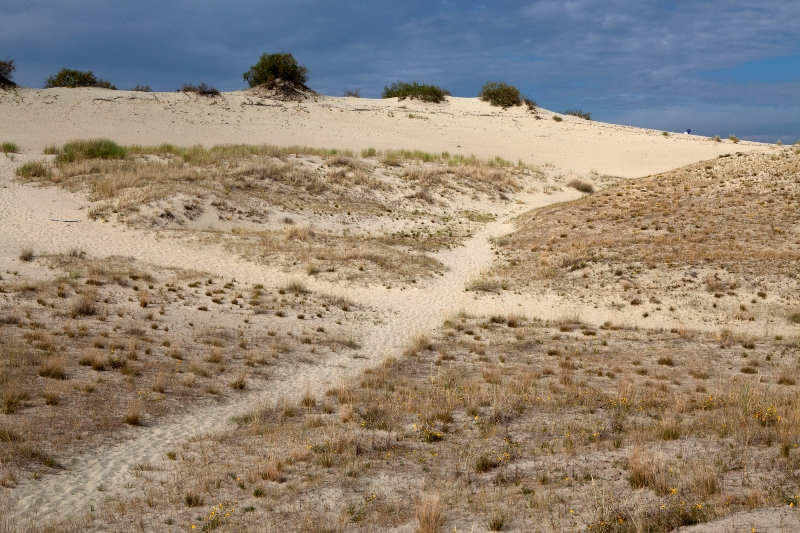
Are your projects ongoing, is there continuity?
Every project has its own time and its own rhythm − some need more than others to develop and ripen. For example Hollow Earth, which started out as a single exhibition with Emilija Škarnulytė, has evolved into more of a platform format – where it takes on different forms and variations depending on the context. It functions as a space where we can explore themes and interests, such as landscape trauma, invisible architecture, and feminist geo-philosophies from an ongoing, subjective perspective.
You work in Small Projects Gallery, what’s your function in there, what do you do? Does working in a gallery (system) have an influence on you as an artist?
Yes, I’m currently the co-director of Small Projects gallery (together with founder Jet Pascua), and my role is basically to do everything that needs to be done in order to run the space; from programming and organizing, to the daily chores of taking out the garbage and watering the plants. I’ve been involved in the organization of artist-run spaces and artistic platforms in both Canada and Norway. The work I do is definitely intertwined with my own individual artistic practice. After seeing how many directors of artist run spaces burn out, I try to be conscious about not only living to serve the gallery − but that the community, the gallery, and the people I invite sustain and fuel my personal practice too.
Artists are often in constant movement: going to different residencies, changing locations, moving through projects, collaborating with different artists and etc. How does it influence you and your work? How many works/projects appear by coincidence just because of this constant move?
I don’t think it’s about coincidence, it’s more that work makes work and one project leads to the next. I like what Miwon Kwon says in One Place After Another:
“It occurred to me some time ago that for many of my art and academic friends, the success and viability of one’s work are now measured by the accumulation of frequent flyer miles. The more we travel for work, the more we are called upon to provide institutions in other parts of the country and the world with our presence and services, the more we give in to the logic of nomadism, one could say, the more we are made to feel wanted, needed, validated and relevant. Our very sense of self-worth seems predicated more and more on our suffering through the inconveniences and psychic destabilizations of ungrounded transience, of not being at home (or not having a home), of always traveling through elsewheres. Whether we enjoy it or not, we are culturally and economically rewarded for enduring the “wrong” place. We are out of place all too often.
Or, perhaps more accurately, the distinction between home and elsewhere, between “right” and “wrong” places, seems less and less relevant in the constitution of the self.”
Is this moving taking you somewhere, are you moving forward? Does all of your work (projects), entirety of them have a common factor (connection)? And if it does, then what? Do you think trough your ideas before making them real? What projects have value to you personally and is there the so called deeper meaning in them? For example what’s the meaning or purpose of your short movie, which you did in Nida? What does it represent, symbolize?
For me, there’s a lot of thought that goes into conceptualizing a new work- it’s sort of torturous actually. At a certain point though it becomes more of an intermingling of thinking and intuitive action. The projects have their own connections, like dreams. I cherish this, because sometimes in the making, they are beyond what I can understand. They become clearer with time.
You call your projects experimental. What’s experimental about them? Would you call your work you made in Nida experimental and why? Jonas Mekas in one of his interviews said “In fact, none of us are experimenting, it was the press that came up with that term. <…> Sure, there is a factor of chance, accident, but when we try out one way of doing things or another, it is not experimenting.” Once you’ve told that for your projects are really interesting only when you discover something, did you discover anything here and what?
I think a lot of cool ideas come from just experimenting and exploring, and that it’s more exciting to play around with the unknown then to make the perfect, planned thing.
What would you advice to artists coming to Nida for 1-2 months? How could they avoid using the same all-around-materials: sand, pines, water, etc. Have you seen in the colony archive (magazines, etc.) any site-specific work which convinced you?
I don’t see any reason in trying to avoid these materials. Guest artists and tourists are drawn to the sand, pines, water, etc because the landscape in Nida is powerful and interesting. There is a lot undiscovered in this landscape − archeologically and also historically- so I think it is a great potential source to dig into. Guests should engage with it, who knows what could be excavated.
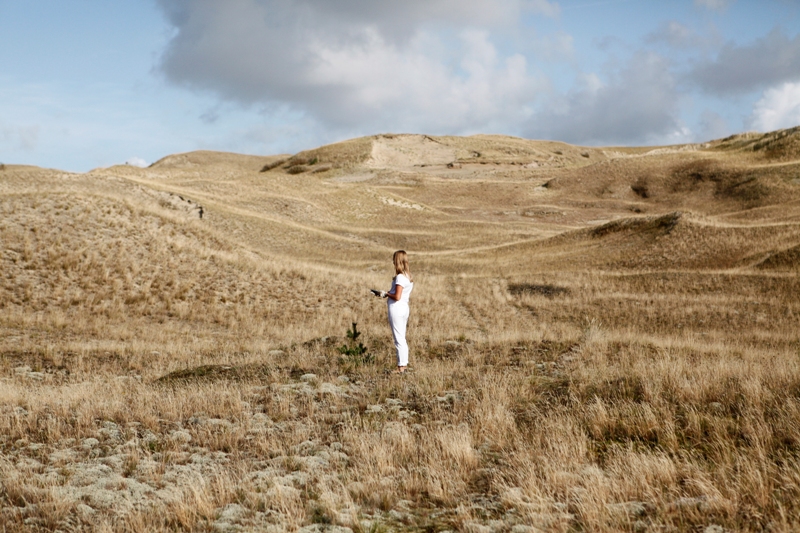
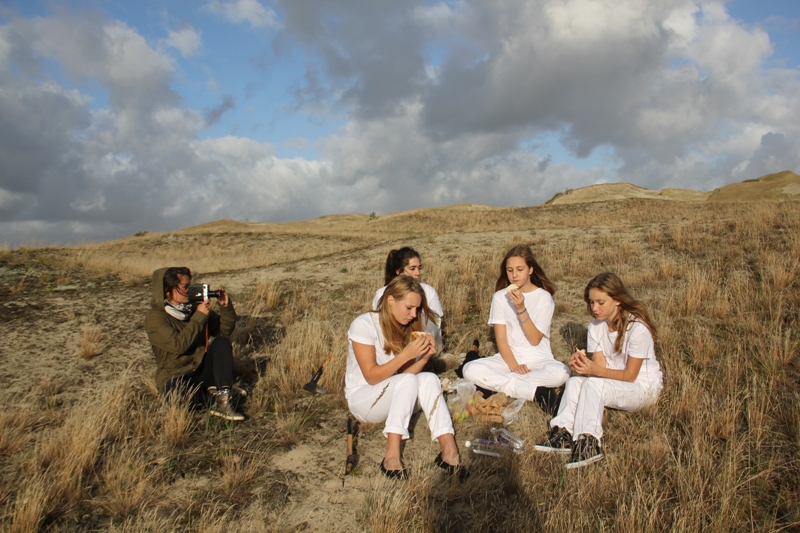
Other related articles: Artist Mobility and the Baltic Cities: Revealing a Transnational Art World










